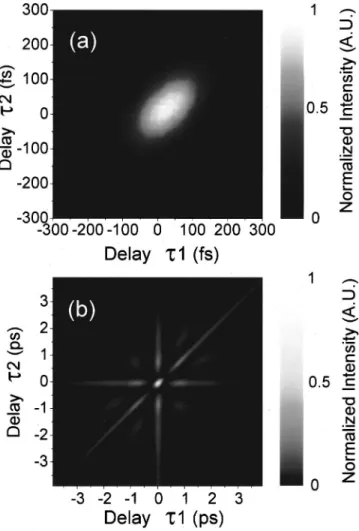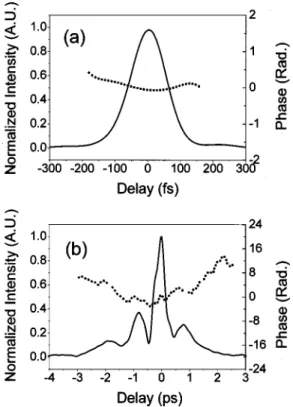Triple-optical autocorrelation for direct optical pulse-shape measurement
Tzu-Ming Liu, Yin-Chieh Huang, Gia-Wei Chern, Kung-Hsuan Lin, Chih-Jie Lee, Yu-Chueh Hung, and Chi-Kuang Suna)
Department of Electrical Engineering and Graduate Institute of Electro-Optical Engineering, National Taiwan University, Taipei 10617, Taiwan, Republic of China
共Received 4 September 2001; accepted for publication 24 June 2002兲
Triple optical autocorrelation of femtosecond optical pulses was realized simply with third-harmonic-generation technique. This optical technique provides complete knowledge of transient pulse intensity variation directly in time domain. Only analytic calculation is needed to obtain the pulse-shape from data without direction-of-time ambiguity. Combined with a spectral measurement and the Gerchberg–Saxton algorithm, except for pulses with complete temporal and spectral symmetry that will cause a twofold ambiguity, exact phase variation in time can also be retrieved through an iterative calculation with an O(n) complexity. © 2002 American Institute of Physics. 关DOI: 10.1063/1.1501453兴
In most time domain applications and studies, measuring the ultrashort optical pulse-shape is a crucial diagnosis. Be-cause electronic devices are too slow to measure temporal evolution of femtosecond optical pulses, it is thus important to develop optical techniques based on slow electronic detec-tors in order to characterize these ultrashort pulses. In past decades there have been great advances in the techniques for measuring ultrashort optical pulses,1–10 however, most of them cannot provide direct optical pulse shape measurement in time domain. Here we present a pure time-domain mea-surement technique, triple optical autocorrelation for direct pulse-shape measurement 共TOAD兲, based on single-stage third-harmonic generation共THG兲. Only analytic calculation is needed to obtain the transient pulse-shape.
By far the most common mean to evaluate femtosecond optical pulses is optical autocorrelation measurement based on second harmonic generation共SHG兲.1,2A Michelson inter-ferometer splits an incident pulse into two replicas with a relative temporal delay. These two pulses are then recom-bined in a SHG crystal. Thus, the generated SHG signal, with one photon contributed from each pulse, is usually de-tected with a photomultiplier tube, and the variation of pho-tocurrent with delay yields the autocorrelation trace. A proper measurement of autocorrelation can provide estima-tion on the pulse duraestima-tion, and with the aid of high order nonlinearity,3–5 some pulse asymmetry information can also be extracted without direction-of-time ambiguity. However complete temporal optical pulse shape cannot be determined directly from these previous proposed two-arm correlations1–5 due to limited information in measurement. Some methods have been developed to obtain enough infor-mation on the measured pulse shape,6 –10 but they needed either iterative algorithm for multidimensional search or spectral information to finish this time-domain work. On the other hand, if another temporal dimension is added on to the two-arm correlation to form a triple correlation, thus ob-tained information will be not only sufficient to completely determine the pulse shape but also direct in time domain
only. In previous studies, it had been shown that a triple correlation function is sufficient to determine the temporal intensity of a pulse with direct mathematical calculation.11,12 Here we realize this technique for direct optical pulse-shape measurement based on simply one stage of a THG effect. According to this method, temporal intensity of optical pulses can be obtained directly without any spectral mea-surement or pulse-shape assumption. Moreover, computer simulation also showed that this suggested method is quite insensitive to noise.13
For an optical pulse, time dependent intensity I(t) can be expressed in frequency domain as
I共t兲⫽
冕
˜I共兲exp共⫺i2t兲d⫽
冕
兩I˜共兲兩exp关i␣共兲⫺i2t兴d, 共1兲 where兩I˜()兩 and␣共兲 are magnitude and phase of I(t) in the frequency domain, respectively. After beam splitting, three replicas of laser pulses are focused on a THG crystal as shown in Fig. 1. If there are temporal overlaps among them, ten possible THG beams will be generated in different spatial directions due to different combinations of three individual photons, for example more than one photon can be contrib-uted from one beam. The specific THG signal generated with only one photon from each replica is spatially selected with an iris according to momentum conservation law. By varying the time delay between pulses,1 and2, and recording the selected THG signals with a detector, the background-free triple correlationG3共
1,2兲⫽
冕
I共t兲I共t⫹1兲I共t⫹2兲dt 共2兲can be directly obtained from the measurement. We can use it and its bispectrum G˜3(1,2), the Fourier transform of the triple correlation function, to calculate兩I˜()兩 and␣共兲11with
兩I˜共兲兩⫽
冑
G˜3共1,0兲/I˜共0兲 共3兲and
a兲Author to whom correspondence should be addressed; electronic mail:
sun@cc.ee.ntu.edu.tw
APPLIED PHYSICS LETTERS VOLUME 81, NUMBER 8 19 AUGUST 2002
1402
␣共兲⫽
冕
0 ␣⬘
共1兲d1 ⫽⫺2冕
0 冋
冕
2cos共211兲G3共1,2兲d1d2冒
冕
cos共211兲G3共1,2兲d1d2册
d1. 共4兲 The temporal optical pulse shape I(t) can then be fully de-termined by substituting them into Eq.共1兲.The optical pulses used to demonstrate this concept came from a mode-locked Cr:forsterite laser operating with a center wavelength of 1230 nm and a bandwidth of 18 nm. The average output power was 280 mW with 110 MHz rep-etition rate. We then misaligned the laser cavity in order to distort the output pulse-shape for TOAD measurement. We split 180 mW of the laser output beam into three mutual parallel and equal distance replicas with beam splitters and used the computer-controlled translation stages to introduce delays among them. After focusing into a 0.45-m-thick p-type gallium nitride, which served as the THG crystal,14 spatially selected THG signals can be easily detected by a CCD based spectrometer around 410 nm. Usually more than 6000 counts can be detected with an integration time of 0.01 s at 0 time delays. Our previous experiments using the same Cr:forsterite laser demonstrated enhanced THG in GaN thin film due to close resonance of defect/doping levels and band-tail states.14With a sample thickness less than the THG co-herent length, which is estimated to be around 1m for GaN with our specific experimental wavelengths,15we can neglect the problems of phase matching angle and phase matching bandwidth. The use of a spectrometer helped us to distin-guish the THG signals from other multiphoton excited pho-toluminescence in GaN.15
Figure 2 shows two examples of TOAD traces. The TOAD trace in Fig. 2共a兲 corresponds to normal laser opera-tion without cavity misalignment, where a single-peak pulse can be observed. The TOAD trace in Fig. 2共b兲 corresponds to the cavity-misaligned operation, where multiple-peaked structure for the laser pulse can be directly found in the trace. It is important to notice the diagonal symmetry in the mea-sured traces, which is the characteristic of triple correlation. Following Eqs. 共1兲–共4兲 without iterative calculations, their corresponding temporal pulse-shapes can then be directly ob-tained. Figures 3共a兲 and 3共b兲 show the recovered temporal intensity profiles 共solid curve兲, which correspond to the
TOAD traces in Figs. 2共a兲 and 2共b兲, respectively. Please no-tice that, besides noise induced measurement errors, Fig. 3 presents the exact pulse-shape 共intensity, not field兲 without direction-of-time ambiguity. Corresponding magnitude dis-tribution of the electric field can be obtained from Fig. 3 by taking a square root.
Once the temporal pulse-shape is obtained, according to Gerchberg–Saxton 共GS兲 algorithm,16,17 phase variation in time can be determined with the help of the corresponding spectrum. Although there are ambiguities in the GS algorithm,18 for optically realizable functions, they rise only for pulses with complete temporal and spectral symmetry that will cause a twofold ambiguity.17Therefore the temporal phase variation can be uniquely determined except for sym-metric pulses with an O(n) complexity in contrast to other SHG-based techniques.6If the twofold ambiguities occur due to a completely symmetric pulse shape or spectral shape, they can be distinguished with an auxiliary measurement. Based on the GS algorithm, we developed a phase retrieval program for phase distribution determination.19 With the TOAD recovered intensity and a measured spectrum, the re-trieved phases are shown in Fig. 3 共dotted curve兲. These results indicated that the method of TOAD can obtain com-plete information of the laser pulses. To investigate this ca-pability of TOAD, we performed our TOAD measurements on the output pulses of a mode-locked Ti:sapphire laser and introduced dispersion by placing a 2-cm-thick BK7 window
FIG. 1. Diagrammatic representation of THG based triple correlation.
FIG. 2. Two THG-based triple correlation traces for pulses from a mode-locked Cr:forsterite laser.
1403 Appl. Phys. Lett., Vol. 81, No. 8, 19 August 2002 Liuet al.
before the TOAD measurement system. According to the dis-persion relation given by Schott Glass,19 the corresponding second-order dispersion evaluated at a wavelength of 780 nm is 930 fs2. The retrieved spectral phase 共Fig. 4兲 shows that the second-order dispersion was increased from 870 fs2 共solid curve兲 to 1800 fs2共dotted curve兲 after introducing the dispersive window, with a positive difference agreed well with the expected value.
Compared to SHG, THG can be generated in any mate-rial, taking advantage of the interface inhomogeneity. Al-though the THG efficiency is⬍10⫺6in our case with a GaN thin film, the signal can already be easily detected by an unamplified Si photodetector. Moreover, some efficient THG crystals have been reported recently.20,21These progresses in THG crystals can improve the THG efficiency in a TOAD measurement, therefore the signal-to-noise ratio or the cost of TOAD.
In conclusion, we demonstrated a triple optical autocor-relation technique for direct optical pulse-shape measure-ment based on third-harmonic generation. Since THG is al-lowed for any materials, our developed technique can be easily realized with little modification on the common auto-correlation setup with a thin film of wide band gap materials. This time-domain technique thus allows quick and easy de-termination of the measured optical pulse shape without it-erative algorithm. Combined with a spectral measurement and Gerchberg–Saxton algorithm, except for pulses with
complete temporal and spectral symmetry that will cause a twofold ambiguity, exact phase in time can also be retrieved, through an iterative calculation with an O(n) complexity.
This work is sponsored by National Science Council of Taiwan, R.O.C. under Grant No. 90-2215-E-002-039. The GaN sample was provided by Y. Smorchkova, S. Keller, S. DenBaars, and U. Mishra from University of California at Santa Barbara. T.-M.L. would like to thank the financial sup-port from SIS Corp.
1M. Maier, W. Kaiser, and J. A. Giordmaine, Phys. Rev. Lett. 17, 1275
共1966兲.
2E. P. Ippen, C. V. Shank, Ultrashort Light Pulses, edited by S. L. Shapiro
共Springer, Berlin, 1977兲.
3D. H. Auston, Appl. Phys. Lett. 18, 249共1971兲.
4E. P. Ippen and C. V. Shank, Appl. Phys. Lett. 27, 488共1975兲. 5P. Langlois and E. P. Ippen, Opt. Lett. 24, 1868共1999兲. 6
D. J. Kane and R. Trebino, Opt. Lett. 18, 823共1993兲.
7
C. Iaconis and I. A. Walmsley, Opt. Lett. 23, 792共1998兲.
8T.-W. Yau, Y.-Y. Jau, C.-H. Lee, and J. Wang, Technical Digest of Confer-ence on Laser and Electro-Optics, Baltimore, Maryland, 23–28 May 1999
共Optical Society of America, Washington DC, 1999兲, pp. 263–264.
9
J. W. Nicholson, J. Jasapara, W. Rudolph, F. G. Omenetto, and A. J. Taylor, Opt. Lett. 24, 1774共1999兲.
10J. W. Nicholson, M. Mero, J. Jasapara, and W. Rudolph, Opt. Lett. 25,
1801共2000兲.
11
E. I. Blount and J. R. Klauder, J. Appl. Phys. 40, 2874共1969兲.
12
T. Feurer, S. Nidermeier, and R. Sauerbrey, Appl. Phys. B: Lasers Opt. 66,
163共1998兲.
13B. Wirnitzer, Opt. Commun. 48, 225共1983兲.
14C.-K. Sun, S.-W. Chu, S.-P. Tai, S. Keller, U. K. Mishra, and S. P.
Den-Baars, Appl. Phys. Lett. 77, 2331共2000兲.
15C.-K. Sun, S.-W. Chu, S.-P. Tai, S. Keller, A. Abare, U. K. Mishra, and S.
P. DenBaars, Scanning 23, 182共2000兲.
16R. W. Gerchberg and W. O. Saxton, Optik共Stuttgart兲 34, 275 共1971兲. 17
A. M. J. Huiser, A. J. J. Drenth, and H. A. Ferwerda, Optik共Stuttgart兲 45,
303共1976兲.
18P. Shiske, Optik共Stuttgart兲 40, 261 共1974兲.
19SCHOTT Optisches Glas-KATALOG 2000 共Schott Glas, Hattenbergstr,
Mainz, Germany兲.
20
D. Yelin, Y. Silberberg, Y. Barad, and J. S. Patel, Phys. Rev. Lett. 82, 3046
共1999兲.
21C. Zhang, H. Wei, Y.-Y. Zhu, H.-T. Wang, S.-N. Zhu, and N.-B. Ming,
Opt. Lett. 26, 899共2001兲. FIG. 3. Recovered temporal intensity共solid curve兲 and phase 共dotted curve兲,
corresponding to the THG triple correlation traces in Fig. 2.
FIG. 4. TOAD retrieved phase spectra of the output pulses from a mode-locked Ti:sapphire laser, centered at 780 nm, with共dotted curve兲 and with-out共solid curve兲 a BK7 window.

